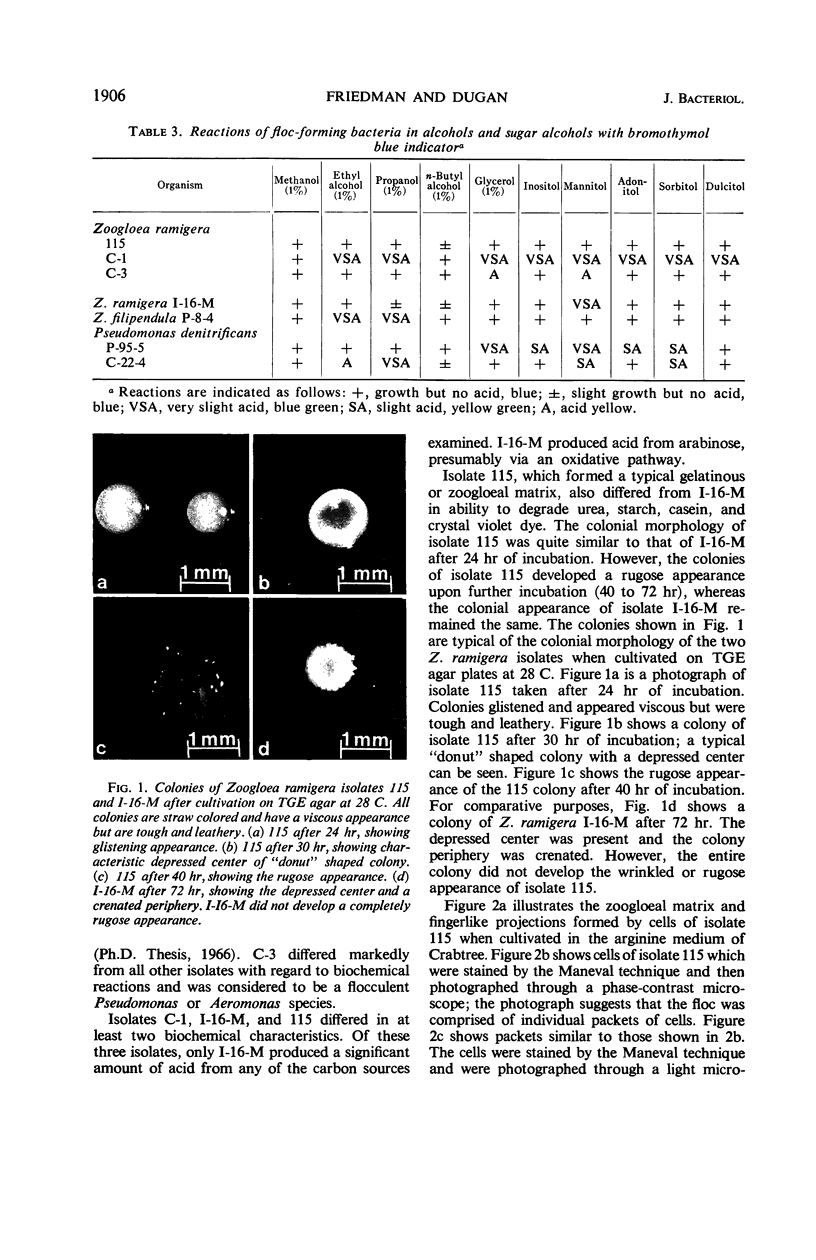Abstract
Three floc-forming, gram-negative, polarly flagellated rods were isolated and characterized. Our isolates were compared to four similar floc-forming organisms previously isolated in another laboratory and classified as two species of Zoogloea, one of Pseudomonas, and as one unidentified gram-negative rod. Possession of zoogloeal matrix or flocculent growth habit was examined in relation to growth and biochemical patterns of the bacteria. A possible relationship of Zoogloea to other gelatinous matrix-producing bacteria is also discussed.
Full text
PDF






Images in this article
Selected References
These references are in PubMed. This may not be the complete list of references from this article.
- Buchanan R. E. Studies on the Nomenclature and Classification of the Bacteria: IV. Subgroups and Genera of the Coccaceae. J Bacteriol. 1917 Nov;2(6):603–617. doi: 10.1128/jb.2.6.603-617.1917. [DOI] [PMC free article] [PubMed] [Google Scholar]
- CRABTREE K., MCCOY E., BOYLE W. C., ROHLICH G. A. ISOLATION, IDENTIFICATION, AND METABOLIC ROLE OF THE SUDANOPHILIC GRANULES OF ZOOGLOEA RAMIGERA. Appl Microbiol. 1965 Mar;13:218–226. doi: 10.1128/am.13.2.218-226.1965. [DOI] [PMC free article] [PubMed] [Google Scholar]
- Crabtree K., Boyle W., McCoy E., Rohlich G. A. A mechanism of floc formation by Zoogloea ramigera. J Water Pollut Control Fed. 1966 Dec;38(12):1968–1980. [PubMed] [Google Scholar]
- DUGAN P. R., LUNDGREN D. G. Isolation of the floc-forming organism Zoogloea ramigera and its culture in complex and synthetic media. Appl Microbiol. 1960 Nov;8:357–361. doi: 10.1128/am.8.6.357-361.1960. [DOI] [PMC free article] [PubMed] [Google Scholar]
- Hardman Y., Henrici A. T. Studies of Freshwater Bacteria: V. The Distribution of Siderocapsa treubii in Some Lakes and Streams. J Bacteriol. 1939 Jan;37(1):97–105. doi: 10.1128/jb.37.1.97-105.1939. [DOI] [PMC free article] [PubMed] [Google Scholar]
- Henrici A. T., Johnson D. E. Studies of Freshwater Bacteria: II. Stalked Bacteria, a New Order of Schizomycetes. J Bacteriol. 1935 Jul;30(1):61–93. doi: 10.1128/jb.30.1.61-93.1935. [DOI] [PMC free article] [PubMed] [Google Scholar]
- Pribram E. A CONTRIBUTION TO THE CLASSIFICATION OF MICROORGANISMS. J Bacteriol. 1929 Dec;18(6):361–394. doi: 10.1128/jb.18.6.361-394.1929. [DOI] [PMC free article] [PubMed] [Google Scholar]
- RICH L. G. Respiration studies on the organic nitrogen preferences of Zoogloea ramigera. Appl Microbiol. 1955 Jan;3(1):20–25. doi: 10.1128/am.3.1.20-25.1955. [DOI] [PMC free article] [PubMed] [Google Scholar]
- Winslow C. E., Rogers A. F. A REVISION OF THE COCCACEAe. Science. 1905 Apr 28;21(539):669–672. doi: 10.1126/science.21.539.669. [DOI] [PubMed] [Google Scholar]




